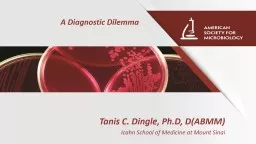

Icahn School of Medicine at Mount Sinai A Diagnostic Dilemma Patient History A 28year old male presents to the Emergency Department ED with a oneday history of sore throat and fever ID: 907880
Download Presentation The PPT/PDF document "Tanis C. Dingle, Ph.D, D(ABMM)" is the property of its rightful owner. Permission is granted to download and print the materials on this web site for personal, non-commercial use only, and to display it on your personal computer provided you do not modify the materials and that you retain all copyright notices contained in the materials. By downloading content from our website, you accept the terms of this agreement.
Slide1
Tanis C. Dingle, Ph.D, D(ABMM) Icahn School of Medicine at Mount Sinai
A Diagnostic Dilemma
Slide2Patient HistoryA 28-year old male presents to the Emergency Department (ED) with a one-day history of sore throat
and
fever
.
Upon examination,
tonsillar swelling
is noted
without pus.
A rapid antigen detection test (RADT) for Group A
Streptococcus
(GAS) performed in the ED is negative.
A
throat swab
is collected for culture.
The patient is sent home with instructions for symptomatic relief of a presumed viral pharyngitis.
The next day the patient returns to the ED with
worsening sore throat
and
difficulty swallowing.
Pus is now seen on the tonsils and the uvula is deviated towards one side of his throat.
Slide3Microbial Causes of Acute PharyngitisViral (60%)Rhinovirus
Adenovirus
Coronavirus
Epstein-Barr virus
Other upper respiratory pathogens
Bacterial (10-15%)Group A StreptococcusGroup C and G StreptococcusArcanobacterium haemolyticumFusobacterium nucleatumCorynebacterium diptheriaeNeisseria gonorrheaOthersNon-infectious or Unknown (25%)
Photo Credits: Centers for Disease Control and Prevention and Flickr (NIAID)
Slide4Processing of Throat Cultures for Bacterial Pathogens
Throat swab is sent to the microbiology laboratory and plated to blood agar
Plates incubated aerobically at 35°C for 24 to 48 hours
A trained microbiologist examines the plates for common bacterial causes of pharyngitis
Photo Credits:
WIkimedia
,
Wikimedia
,
Wikimedia
Throat is swabbed in the area of the
tonsils
Slide5Laboratory ResultsThe clinical microbiologist notes β-hemolytic colonies on the blood agar plate after 24 hours incubation.
A Gram stain of a colony reveals
Gram-positive cocci
growing in
long
chains.The organism is catalase negative and susceptible to the antibiotic/biochemical bacitracin.
Photo Credit: Centers for Disease Control and Prevention
Slide6Diagnosis
Peritonsillar
abscess caused by Group A Streptococcus (
Streptococcus
pyogenes
)
The final diagnosis could only be made by performing throat culture in the microbiology laboratory since the rapid antigen test result was falsely negative.
Photo Credit:
Wikimedia
Slide7Potential Complications of
Group A Streptococcal Pharyngitis
Suppurative
(pus)
Non-
Suppurative
Peritonsillar
abscess
Acute
rheumatic fever
Lymphadenitis
Acute glomerulonephritis
Sinusitis
Otitis Media
Mastoiditis
Invasive infections (e.g. toxic shock syndrome, necrotizing
fasciitis)
Slide8Sensitivity of Diagnostic Tests for GAS Pharyngitis
RADT
55-85% sensitive
1,2
Throat Culture
95% sensitive
3
Lower sensitivity of RADT indicates false negative results are not uncommon
Reflexive culture of specimens with negative RADT results is recommended for diagnosing GAS
Since RADT is highly specific for GAS, specimens with positive results do not need to be cultured
Slide9Patient OutcomeDue to the false negative RADT, the patient was initially sent home without antimicrobial treatment.
A throat culture performed by the microbiology laboratory led to the diagnosis of Group A streptococcal
pharyngitis.
Upon receipt of the culture results, the physician contacted the patient for follow
up.
The patient’s peritonsillar abscess was drained and the patient was treated for 10 days with penicillin.The patients symptoms completely resolved with this course of treatment.
Slide10Tanis C. Dingle, Ph.D, D(ABMM)Dr. Dingle is an Associate Professor in the Department of Pathology at the Icahn School of Medicine at Mount Sinai and Co-Assistant Director of Microbiology for the Mount Sinai Health System in New York City. Dr. Dingle is a Diplomate of the American Board of Medical Microbiology and trained in the CPEP program at the University of Washington in Seattle. Her research interests include antimicrobial resistance and the application of MALDI-TOF mass spectrometry in the clinical microbiology laboratory.
Photo Provided by Tanis Dingle, Ph.D., D(ABMM)